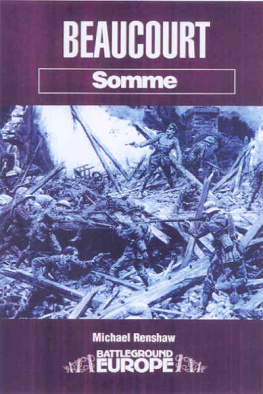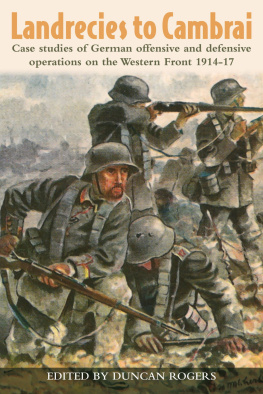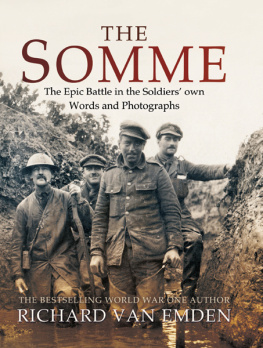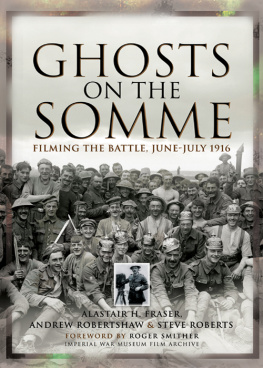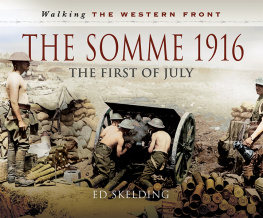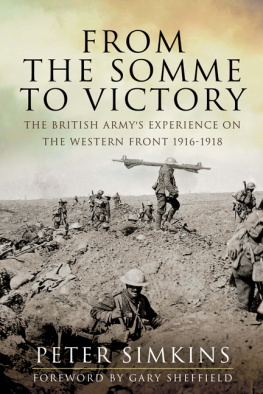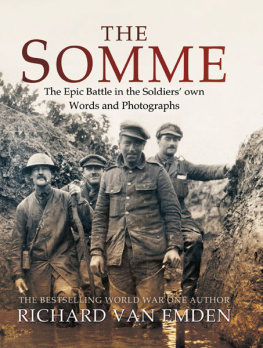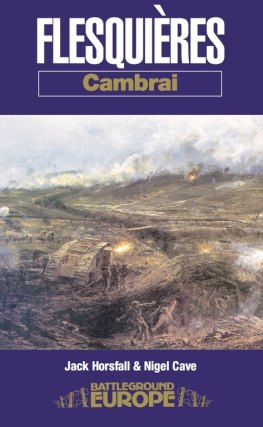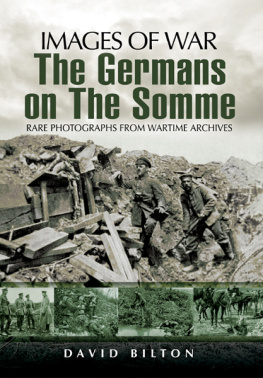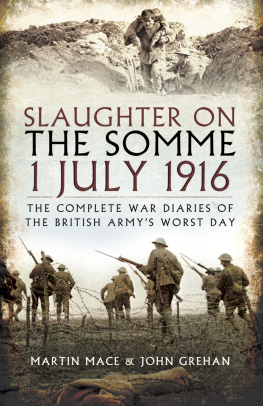Other guides in the Battleground Europe Series:
Walking the Salientby Paul Reed
Ypres - Sanctuary Wood and Hoogeby Nigel Cave
Ypres - Hill 60by Nigel Cave
Ypres - Messines Ridgeby Peter Oldham
Ypres - Polygon Woodby Nigel Cave
Ypres - Passchendaeleby Nigel Cave
Ypres - Airfields and Airmenby Michael OConnor
Ypres - St Julienby Graham Keech
Walking the Sommeby Paul Reed
Somme - Gommecourtby Nigel Cave
Somme - Serreby Jack Horsfall & Nigel Cave
Somme - Beaumont Hamelby Nigel Cave
Somme - Thiepvalby Michael Stedman
Somme - La Boisselleby Michael Stedman
Somme - Fricourtby Michael Stedman
Somme - Carnoy-Montaubanby Graham Maddocks
Somme - Pozieresby Graham Keech
Somme - Courceletteby Paul Reed
Somme - Boom Ravineby Trevor Pidgeon
Somme - Mametz Woodby Michael Renshaw
Somme - Delville Woodby Nigel Cave
Somme - Advance to Victory (North) 1918by Michael Stedman
Somme - Flersby Trevor Pidgeon
Somme - Bazentin Ridgeby Edward Hancock
Somme - Comblesby Paul Reed
Somme - Hamelby Peter Pedersen
Arras - Vimy Ridgeby Nigel Cave
Arras - Gavrelleby Trevor Tasker and Kyle Tallett
Arras - Bullecourtby Graham Keech
Arras - Monchy le Preuxby Colin Fox
Hindenburg Lineby Peter Oldham
Hindenburg Line Epehyby Bill Mitchinson
Hindenburg Line Riquevalby Bill Mitchinson
Hindenburg Line Villers-Plouichby Bill Mitchinson
Hindenburg Line - Cambrai, Right Hookby Jack Horsfall & Nigel Cave
Hindenburg Line - Saint Quentinby Helen McPhail and Philip Guest
Hindenburg Line - Bourlon Woodby Jack Horsfall & Nigel Cave
La Basse - Neuve Chapelleby Geoffrey Bridger
Loos - Hohenzollernby Andrew Rawson
Loos - Hill 70by Andrew Rawson
Monsby Jack Horsfall and Nigel Cave
Accrington Pals Trailby William Turner
Poets at War: Wilfred Owenby Helen McPhail and Philip Guest
Poets at War: Edmund Blundenby Helen McPhail and Philip Guest
Poets at War: Graves & Sassoonby Helen McPhail and Philip Guest
Gallipoliby Nigel Steel
Gallipoli - Gully Ravineby Stephen Chambers
Gallipoli - The Landings At Helles by Huw & Jill Rodge
Walking the Italian Frontby Francis Mackay
Italy - Asiagoby Francis Mackay
Verdunby Christina Holstein
Boer War - The Relief of Ladysmithby Lewis Childs
Boer War - The Siege of Ladysmithby Lewis Childs
Boer War - Kimberleyby Lewis Childs
Isandlwanaby Ian Knight and Ian Castle
Rorkes Driftby Ian Knight and Ian Castle
Wars of the Roses - Wakefield/Towtonby Philip A. Haigh
English Civil War - Nasebyby Martin Marix Evans, Peter Burton and Michael Westaway
Napoleonic - Hougoumontby Julian Paget and Derek Saunders
Napoleonic - Waterlooby Andrew Uffindell and Michael Corum
WW2 Pegasus Bridge/Merville Batteryby Carl Shilleto
WW2 Utah Beachby Carl Shilleto
WW2 Gold Beachby Christopher Dunphie & Garry Johnson
WW2 Normandy - Gold Beach Jigby Tim Saunders
WW2 Omaha Beachby Tim Kilvert-Jones
WW2 Sword Beachby Tim Kilvert-Jones
WW2 Hill 112by Tim Saunders
WW2 Normandy - Epsomby Tim Saunders
WW2 Normandy - Operation Bluecoatby Ian Daglish
WW2 Battle of the Bulge - St Vithby Michael Tolhurst
WW2 Battle of the Bulge - Bastogneby Michael Tolhurst
WW2 Dunkirkby Patrick Wilson
WW2 Calaisby Jon Cooksey
WW2 Boulogneby Jon Cooksey
WW2 Das Reich Drive to Normandyby Philip Vickers
WW2 Market Garden - Nijmegenby Tim Saunders
WW2 Market Garden - Hells Highwayby Tim Saunders
WW2 Market Garden - Arnhem, Oosterbeekby Frank Steer
WW2 Market Garden - The Islandby Tim Saunders
WW2 Channel Islandsby George Forty
Battleground Europe Series guides under contract for future release:
Stamford Bridge & Hastingsby Peter Marren
Somme - High Woodby Edward Hancock
Somme - German Advance 1918by Michael Stedman
Somme - Redan Ridge by Michael Renshaw
Walking Arrasby Paul Reed
Fromellesby Peter Pedersen
WW2 Normandy - Mont Pinonby Eric Hunt
WW2 Market Garden - Arnhem, The Bridgeby Frank Steer
WW2 Normandy - Falaiseby Tim Kilvert-Jones
WW2 Walcherenby Andrew Rawson
With the continued expansion of the Battleground series a Battleground Series Club has been formed to benefit the reader. The purpose of the Club is to keep members informed of new titles and to offer many other reader-benefits. Membership is free and by registering an interest you can help us predict print runs and thus assist us in maintaining the quality and prices at their present levels.
Please call the office 01226 734555, or send your name and address along with a request for more information to:
Battleground Series Club Pen & Sword Books Ltd,
47 Church Street, Barnsley, South Yorkshire S70 2AS
First published in 2003 by
LEO COOPER
an imprint of
Pen & Sword Books Limited
47 Church Street, Barnsley, South Yorkshire S70 2AS
Copyright Michael Renshaw, 2003
ISBN 0 85052 853 4
PDF ISBN: 9781783377510
EPUB ISBN: 9781783379712
PRC ISBN: 9781783379514
A CIP catalogue of this book is available
from the British Library
Printed by CPI UK
For up-to-date information on other titles produced under the Leo Cooper imprint,
please telephone or write to:
Pen & Sword Books Ltd, FREEPOST, 47 Church Street
Barnsley, South Yorkshire S70 2AS
Telephone 01226 734222
CONTENTS
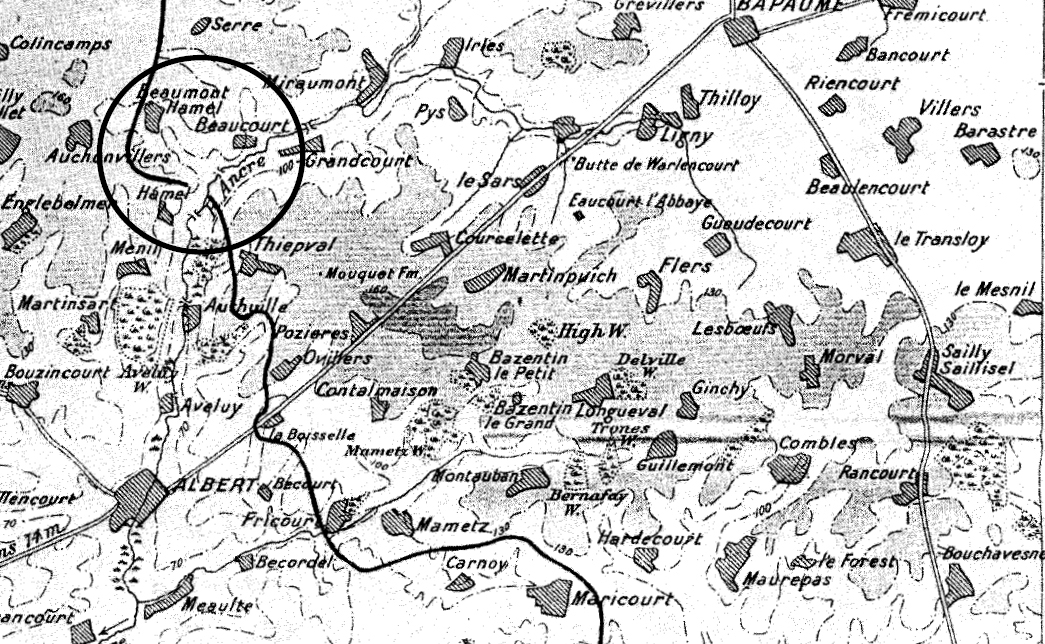
Section of map of area within which the book is based.
Introduction by the Series Editor
Beaucourt is a quiet and sleepy place, snoozing gently by the lazy Ancre. It is hard to imagine that it could ever have been the scene of such ferocious fighting as that which took place here in November 1916, in the dying throes of the Battle of the Somme. The battle here reveals something about the improvement in the capability of the British army in the field: men were more willing to take the initiative, systems were more flexible, the use of weapons had improved - all the consequence of the ghastly (and, of course, ghastly for both sides, a point often ignored) grinding battles which taught lessons in a terrible and unforgiving way.
Although Beaucourt is best remembered for the fighting in that gloomy, sodden and cold November (and in personality terms, remembered for the VC won by Bernard Freyberg), there was fighting along the northern bank of the Ancre prior to this. Most especially the action of a brigade of the 36th (Ulster) Division on 1st July is often forgotten; perhaps because it was as unsuccessful as the attacks of the other British formations north of the Ancre on that fateful day. Certainly it did not have the same possibilities of the extraordinary advances, though lost, by the two sister brigades south of the river.
Next page
